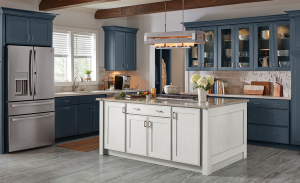A kitchen remodel can transform your cooking experience from a chore to a fun family activity. Functionality may include expanding storage space, improving work flow, or upgrading appliances and fixtures.
Focus on timeless designs and quality materials. Choosing products that will not date or quickly become obsolete is important to maintain your investment and resale value. Click https://www.tacomakitchenremodel.com/ to learn more.

A well-designed kitchen layout maximizes functionality and efficiency, making it easier to work in the room. An effective design adheres to a number of important principles, such as the “Work Triangle,” which involves strategically positioning the sink, refrigerator, and stove to promote efficient movement and streamline workflow.
Other essential factors include zoning, which allows homeowners to set aside different areas for specific tasks and improve organization. For example, a Galley Kitchen layout is ideal for smaller spaces since it uses the space efficiently and features a clear path between workspaces. Moreover, a clear path ensures that cooking activities aren’t interrupted by unnecessary clutter.
Besides improving functionality, kitchen remodeling can also enhance aesthetics. For example, the installation of high-quality materials and appliances helps achieve a modern and updated look. In addition, a re-working of the lighting and color scheme helps establish a welcoming and stylish environment.
Kitchen Remodeling is a major undertaking that can significantly transform the appearance and layout of a kitchen. It may involve significant structural changes, such as removing walls or expanding the footprint of the kitchen. However, it can also include luxury upgrades, such as custom cabinetry and high-end appliances.
The main reason why people choose to remodel their kitchens is to improve the functional layout and overall look. In addition, many people want to add modern features, such as state-of-the-art appliances and smart home technology. Other common reasons include a desire to update the layout to accommodate family or entertaining needs, or the need to make energy-efficient improvements.
When it comes to choosing a contractor for your kitchen remodeling project, be sure to hire one who has extensive experience and specializes in kitchen remodeling. Inexperienced contractors often struggle with complex projects and can cause damage to the existing structure and finish. Additionally, they may use substandard materials and appliances that don’t provide lasting value.
A good way to find a qualified contractor is to ask for referrals from friends and neighbors. You can also visit big-name building supply stores that offer kitchen remodeling services. In most cases, these stores will partner with local contractors who can handle the installation.
Aesthetics
While aesthetics is a vital aspect of kitchen design, it’s important to prioritize functionality. After all, the kitchen is a hub for preparing food and enjoying family time. A well-designed kitchen minimizes movement and maximizes efficiency, which ensures that daily tasks can be completed in a timely manner. By optimizing layouts, incorporating smart storage solutions, choosing durable materials, and embracing thoughtful design details, you can create a kitchen that’s both beautiful and functional.
Cabinets are a defining feature of any kitchen and set the tone for its overall design aesthetic. Modern aesthetics favor clean lines and a clutter-free appearance, with handle-less doors and slab-style drawers adding to the streamlined look. Stainless steel and sleek wood finishes are common in modern kitchens, with rift cut or quarter sawn white oak popular choices. Minimalist design aesthetics also favor hidden storage solutions to keep cabinets uncluttered and easy to maintain.
Countertops and backsplashes are another important kitchen design element that impact both aesthetics and functionality. Durable and easy to clean surfaces like quartz, granite, or marble add an elegant appeal to any kitchen. Backsplash tiles with intricate designs and colors can add a pop of personality that aligns with your cooking style and kitchen ambiance.
Lighting is another crucial component of a kitchen’s design that combines functionality and aesthetics. Layering different kinds of lighting provides balance and a seamless, integrated look. For example, recessed lighting can provide general illumination while pendant lights over an island or decorative sconces can highlight architectural features for a more appealing look.
While a complete kitchen overhaul is ideal for many homeowners, some choose to remodel their kitchens on a smaller scale. This type of kitchen renovation typically involves repainting or refacing cabinetry and replacing appliances to improve the look of the space without changing the layout. This can be a cost-effective way to breathe new life into the heart of your home, especially in Temecula where many homes are older and have a more outdated kitchen.
Value
A kitchen remodel is one of the best home improvement projects for increasing a house’s value. This is because potential buyers place a greater emphasis on this room than they do on other rooms, such as the master bedroom and living room. In addition, a kitchen remodel is typically cheaper than other home improvement projects, such as a bathroom remodel or installing new flooring.
However, it is important to note that the resale value of your kitchen remodel is not the only factor to consider. You should also consider how much pleasure you will get out of your kitchen remodel and whether the remodel meets your aesthetic and functional needs.
If you are unsure about what type of kitchen remodel is right for you, it can help to consult a professional. This will ensure that you get the best value out of your investment and avoid making costly mistakes.
A major difference between remodeling and renovating is that remodeling involves altering the structure of the kitchen and changing its layout. On the other hand, renovation focuses on refreshing or upgrading elements of the kitchen without drastically changing its overall design or structure. This can include painting, re-facing or replacing cabinets, and adding or updating appliances.
It is also worth noting that a minor kitchen refresh has a higher ROI than a major kitchen remodel. This is because minor updates tend to focus on color and style rather than structural changes. For this reason, they are often less expensive than a major kitchen remodel and may still provide an excellent return on investment.
In general, it is advisable to stick with the 10% rule when planning your kitchen remodel. This means that you should only spend 10 percent of your home’s current value on a remodel. This way, you can rest assured that the project will be affordable and that you won’t have any trouble selling your home in the future.
When planning a kitchen remodel, it is important to consider both functionality and aesthetics. This will help you create a beautiful and functional kitchen that both you and potential buyers will love. It is also a good idea to choose a contractor who can advise you on the latest trends in kitchen remodeling. For example, choosing an attractive but durable material for your counters or using a bold color on your walls can make a big difference in your kitchen’s look and feel.
Socialization
A kitchen is a social hub that brings families together. Kitchen remodeling can make it a more welcoming space for family and friends to gather and enjoy meals together. Studies and personal anecdotes consistently highlight how a well-designed kitchen can foster a sense of fulfillment and connection in a home. By choosing design elements that encourage socialization and incorporating functional features, you can transform your kitchen into the gathering place of your household.
A good starting point for transforming your kitchen into a social space is to create an open layout that removes walls or barriers. This can be done by removing partitions, or simply opening up a wall and adding an opening to adjoining rooms. This makes it easy to move between rooms and interact with others in those spaces without having to go back and forth through your kitchen.
Another way to create a social space is to incorporate seating areas. This could be a comfortable chair or sofa in the corner of your kitchen, or it could be an island or breakfast bar that provides additional countertop space for food preparation and offers the opportunity to sit and chat with friends or family while you cook. Incorporating a dining table in your kitchen is also a great way to encourage socialization. Having multiple places to sit in your kitchen will also help keep guests out of the main work area so you can concentrate on cooking.
If you plan to entertain frequently, then creating a kitchen with ample storage is essential. This will allow you to store items like extra platters, serving bowls, and other equipment that can be easily accessed when entertaining. Additionally, keeping all of your cookware, utensils, and other kitchen tools in one place will help prevent you from having to continually lug them between cabinets and into storage.
While a kitchen remodel may be an investment, it can offer significant long-term value. By utilizing various design elements, implementing functional features, and incorporating personal touches that reflect your style, you can transform your kitchen into the heart of your home.
